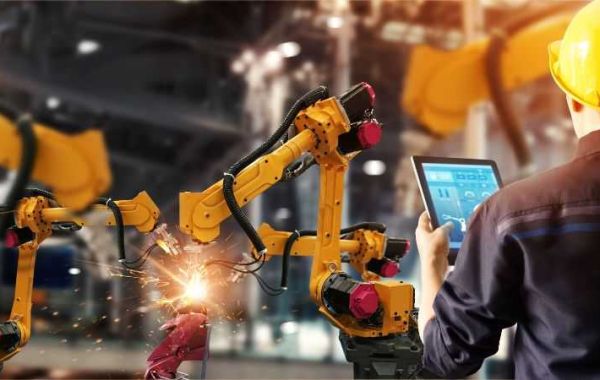The global industrial control and factory automation market size reached a value of about USD 151.35 billion in 2023. The industry is further expected to grow at a CAGR of 7.90% in the forecast period of 2024-2032 to reach a value of around USD 299.24 billion by 2032. This exponential growth is fueled by advancements in technology, particularly artificial intelligence (AI). AI has revolutionized factory automation, enhancing efficiency, productivity, and safety in industrial processes. This blog explores the evolution of AI in factory automation, its applications, benefits, challenges, and future outlook.
Evolution of AI in Factory Automation
The integration of AI in industrial settings has a long history, dating back to the early adoption of AI in robotic arms and machine learning algorithms. In the early stages, AI was primarily used for simple tasks such as pick-and-place operations in manufacturing. However, with advancements in computing power and AI algorithms, its capabilities have expanded significantly. The development of deep learning techniques, such as neural networks, has enabled AI systems to process and analyze vast amounts of data, leading to more sophisticated applications in factory automation.
Applications of AI in Factory Automation
AI is widely used in factory automation for various applications, each contributing to improving efficiency, quality, and safety in manufacturing processes:
Robotics and Autonomous Systems: AI-driven robots are increasingly being used in manufacturing environments for tasks such as assembly, material handling, and inspection. These robots can perform complex tasks with precision and consistency, leading to increased productivity and reduced labor costs.
Predictive Maintenance: AI algorithms analyze data from sensors and machinery to predict potential equipment failures before they occur. By identifying early signs of deterioration or malfunction, predictive maintenance helps minimize downtime and maintenance costs, thereby improving overall equipment effectiveness (OEE) and prolonging asset lifespan.
Quality Control: AI-powered vision systems are used for automated quality inspection in manufacturing processes. These systems use cameras and image processing algorithms to detect defects, deviations, or anomalies in products, ensuring that only high-quality products reach the market. AI-based quality control not only improves product quality but also reduces the likelihood of recalls and warranty claims.
Process Optimization: AI algorithms optimize production processes by analyzing data from various sources, including sensors, actuators, and production databases. By identifying inefficiencies, bottlenecks, and optimization opportunities, AI helps improve resource utilization, minimize waste, and maximize throughput. From scheduling and routing optimization to energy management and supply chain planning, AI-driven process optimization leads to significant cost savings and competitive advantages.
Benefits of AI in Factory Automation
The adoption of AI in factory automation offers several compelling benefits to manufacturers:
Increased Productivity: AI-driven automation streamlines production processes, reduces cycle times, and eliminates bottlenecks, leading to higher throughput and productivity. By automating repetitive tasks, AI allows human workers to focus on more value-added activities, such as problem-solving and innovation.
Cost Savings: AI-driven automation reduces labor costs associated with manual labor, overtime, and human errors. Predictive maintenance helps minimize unplanned downtime and maintenance expenses, while quality control systems reduce scrap, rework, and warranty costs. Overall, AI helps manufacturers optimize their operations and improve their bottom line.
Enhanced Safety: AI-controlled systems can handle dangerous or hazardous tasks, reducing the risk of accidents and injuries to human workers. By automating tasks such as material handling, welding, and assembly, AI improves workplace safety and creates a safer working environment for employees.
Challenges and Considerations
Despite its numerous benefits, the adoption of AI in factory automation also presents several challenges and considerations for manufacturers:
Data Privacy and Security: AI systems require access to large volumes of data, including sensitive information about products, processes, and operations. Protecting this data from unauthorized access, cyber threats, and data breaches is essential to maintaining the integrity and security of AI-driven automation systems.
Workforce Implications: The increasing automation of manufacturing processes raises concerns about job displacement and the impact on the workforce. While AI-driven automation creates new opportunities for skilled workers in areas such as data analysis, programming, and system maintenance, it also requires reskilling and upskilling of existing workers to adapt to changing job roles and responsibilities.
Integration Challenges: Integrating AI systems with existing infrastructure, equipment, and software applications can be complex and time-consuming. Manufacturers need to carefully plan and execute the integration process to ensure compatibility, interoperability, and scalability of AI-driven automation solutions.
Case Studies
Several companies have successfully implemented AI in factory automation, demonstrating the tangible benefits of AI-driven automation:
Automotive Manufacturing: A leading automobile manufacturer used AI-driven robots in its assembly line to improve efficiency and flexibility. By deploying collaborative robots (cobots) equipped with AI-powered vision systems, the company achieved significant productivity gains and reduced time-to-market for new vehicle models.
Food Processing Industry: A multinational food processing company implemented AI for predictive maintenance of its production equipment. By analyzing data from sensors and IoT devices, the company was able to anticipate equipment failures and schedule maintenance proactively, minimizing downtime and optimizing asset utilization.
Click here to checkout our other reports:- https://www.expertmarketresearch.com.au/







